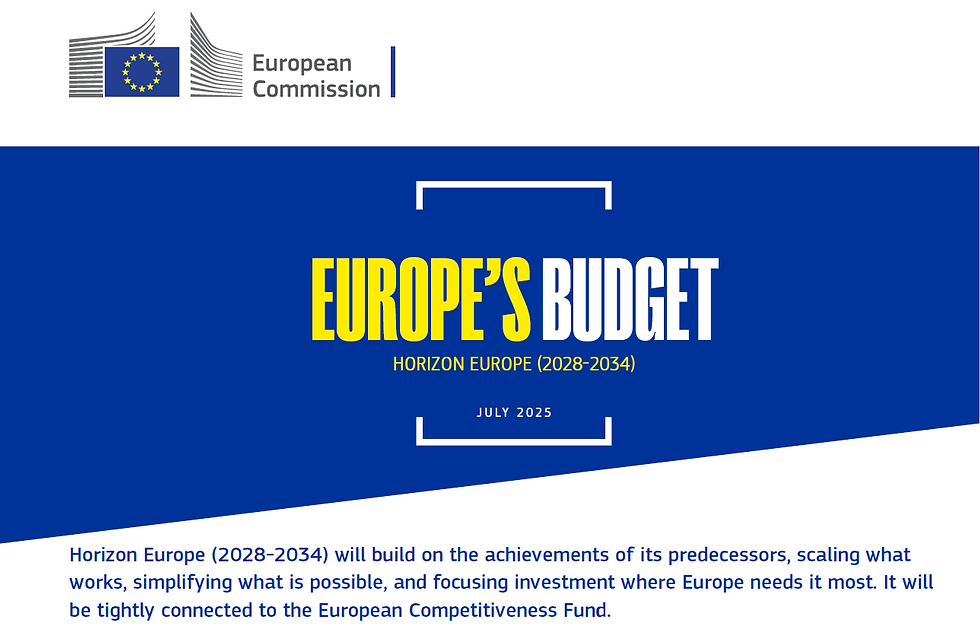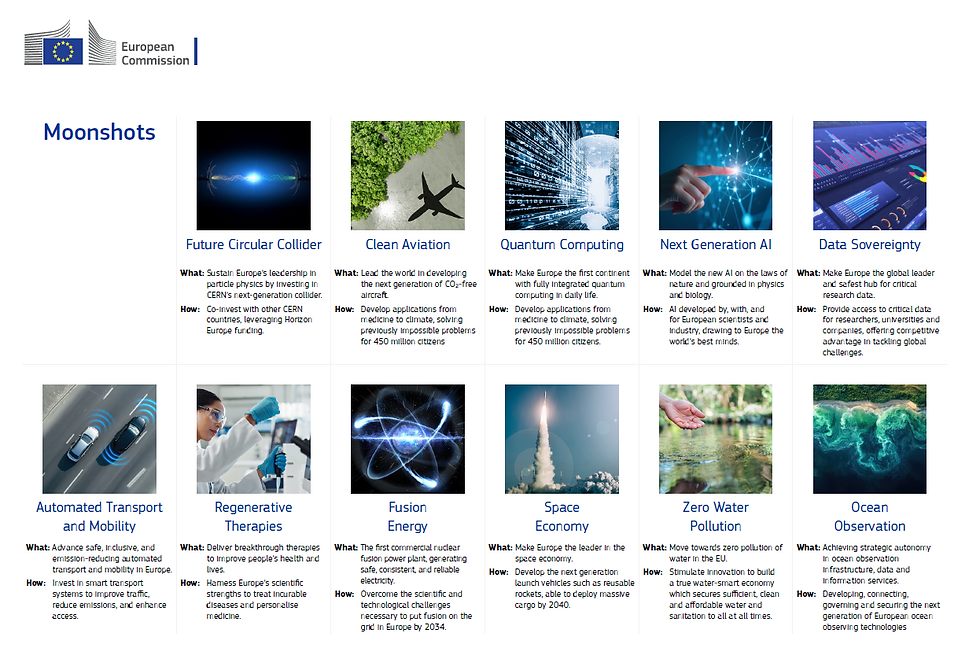Horizon Europe 2028-2034 at a glance
- Rita

- Jul 24
- 6 min read
Europe’s next research & innovation (R&I) flagship is almost ready for lift-off. The newly-proposed Horizon Europe (HEU) programme for 2028-2034 comes with a record budget of €175 billion in current prices and a sharper strategic focus that come together with the forthcoming European Competitiveness Fund. The following presents a professional perspective on recent developments, their significance, and strategies for organizations to proactively position themselves.
Horizon Europe 2028-2034: A four-pillar architecture that mirrors the innovation journey
At the core of the proposed 2028–2034 Horizon Europe programme is a new four-pillar structure that better reflects how innovation actually unfolds from frontier research to market deployment, and from capacity-building to competitiveness. Each pillar has a clear mission, dedicated budget, and streamlined tools to accelerate progress across Europe’s research and innovation landscape.
Pillar | Purpose | What’s new |
I. Excellent Science | Keep Europe at the scientific frontier | Bigger European Research Council (ERC) and reinforced Marie-Skłodowska-Curie Actions (MSCA) |
II. Competitiveness & Society | Collaborative R&I in clean tech, health-bio, digital leadership, security & democracy | Strategic programming guided by an Observatory of Emerging Technologies |
III. Innovation | Scale high-risk, high-impact innovation | An upgraded European Innovation Council (EIC) with ARPA-style “challenge portfolios” and a new DARPA-like track for dual-use/defense start-ups |
IV. European Research Area (ERA) | Cohesion and capacity building | Dedicated actions for widening participation, reforming national R&I systems, and supporting research/technology infrastructures |
2. Key shifts in funding mechanisms
The next Horizon Europe framework introduces a more standardised funding model that affects how proposals are built and evaluated:
A single default funding rate will apply, typically 100% for most participants and 70% for large for-profit companies.
Lump-sum budgets will be used more widely, alongside unit-cost approaches for personnel.
The time-to-grant will be reduced to seven months, enabling faster project starts and earlier resource mobilization.
These changes place greater emphasis on upfront clarity, tight budgeting logic, and strategic framing - areas where experienced proposal developers and project designers will continue to play a vital role.
3. Deep-tech scale-up, the EIC way
The revamped European Innovation Council (EIC) remains the EU’s flagship for high-risk, high-potential innovation, especially for start-ups and SMEs. It retains its well-known “Open” and “Challenges” calls, but now layers in new instruments and a more active management model that draws direct inspiration from DARPA (Defense Advanced Research Projects Agency) and ARPA-E (Advanced Research Projects Agency) in the U.S.
Key additions include:
Stage-gated, ARPA-style oversight: Expert Programme Managers will lead challenge portfolios, clusters of related projects targeting a shared breakthrough goal (e.g. quantum sensors, zero-carbon aviation). These managers are empowered to reallocate funds, terminate underperforming projects, and push high-performers forward. This model rewards adaptability and boldness, not just well-polished Gantt charts.
A dedicated defense and dual-use track: This window connects the EIC with instruments like the European Competitiveness Fund and InvestEU, aiming to support frontier technologies with security or strategic relevance. Think of dual-use AI, space-tech, resilient semiconductors, and encrypted communications.
This evolution makes EIC calls look and feel more like deep-tech venture capital than classic Horizon 2020 grant schemes. Proposals are expected to be sharper on business potential, scalability, and go-to-market strategy, areas where many research-focused SMEs and first-time applicants may feel unprepared or overwhelmed.
The bar is rising: instead of ticking boxes in long annexes, applicants will need to demonstrate urgency, feasibility, and investor-readiness from day one. For those ready to rise to the challenge, this opens the door to faster, more substantial, and more hands-on support than ever before. For others, this shift signals the need for experienced guidance to navigate the cultural and procedural learning curve.

4. Stronger innovation ecosystems
The Specific Programme sketches EU-wide connected hubs linking innovators with investors, buyers, test beds and talent. Early-stage venture-building, place-based tools and “soft-landing” support for internationalization are explicitly mentioned which is good news for start-ups aiming for rapid market entry.
5. Research & Technology Infrastructures: CAPEX finally on the table
Under Pillar IV - European Research Area, the upcoming Horizon Europe programme introduces a significant shift: for the first time, EU funds will be able to cover up to 20% of the construction costs of new or upgraded world-class research infrastructures. This goes beyond the traditional support for operations and access.
In parallel, the programme reinforces support for technology infrastructures, such as pilot lines, test beds, and demonstration platforms, that help bridge the gap between research and industrial deployment. These facilities will offer dedicated access schemes for SMEs and innovators, with a strong emphasis on trans-national use, data interoperability, and FAIR principles (Findable, Accessible, Interoperable, Reusable).
For organizations involved in experimental validation, prototyping, or scale-up activities, this opens new opportunities to co-invest in infrastructure and to access cutting-edge platforms beyond national borders especially when coupled with ERA-wide widening and cohesion instruments.
6. Moonshot: Mission-scale breakthroughs backed by multi-pillar funding
The new Horizon Europe framework introduces an ambitious “Moonshots” portfolio, a select group of large-scale innovation missions targeting transformational impact across strategic domains. These Moonshots are co-funded with the European Competitiveness Fund and will mobilize resources across all four pillars of the programme, pooling fundamental research, technological innovation, industrial deployment, and policy support.
The initial Moonshot themes include:
Future Circular Collider: sustaining Europe’s leadership in particle physics by investing in CERN’s next-gen accelerator
Clean Aviation: developing CO₂-free aircraft for global leadership in sustainable air transport
Quantum Computing: integrating quantum systems into daily life for applications from medicine to climate
Next Generation AI: modelling AI on laws of nature, grounded in physics and biology, developed by and for Europe
Data Sovereignty: ensuring Europe becomes the safest and most competitive global hub for research data
Fusion Energy: building the first commercial fusion power plant to deliver clean and reliable electricity by 2034
Ocean Observation and Zero Water Pollution: deploying next-gen infrastructures and innovations to protect Europe’s waters
Automated Transport, Regenerative Therapies, and Space Economy: addressing mobility, health, and access-to-space challenges with breakthrough technologies
These projects go beyond traditional calls. They aim to create EU-scale flagship initiatives, combining R&I with investment, regulation, and strategic autonomy.
For organizations like NETO Innovation and our clients, Moonshots represent long-term opportunities to embed deep expertise, coordinate multi-actor partnerships, and shape flagship programmes from the ground up. Early positioning, whether as innovation managers, exploitation leaders, or ecosystem builders, will be key to accessing these billion-euro missions.

7. Materials as a cross-cutting enabler
Materials science and technology are deeply embedded across the programme’s structure. From lightweight composites in Clean Aviation, to fusion-grade materials for future energy systems, to biodegradable packaging and smart coatings for circularity, materials remain essential to European innovation leadership.
Pillar II is expected to channel significant funding into advanced materials for industrial transformation, clean tech, health, and mobility. Moonshot missions like Fusion Energy, Quantum Computing, and Ocean Observation also rely on breakthroughs in functional materials, nanostructures, and surface technologies. Meanwhile, Technology Infrastructures under Pillar IV will support pilot lines and testing environments that directly benefit materials developers and users.
For R&D actors and SMEs active in material innovation, this programme presents multiple routes to impact, whether through collaborative projects, Pathfinder-style explorations, or infrastructure access schemes. NETO Innovation’s project portfolio, from biodegradable films to printed and flexible electronics, is well-positioned to capture these cross-pillar opportunities.
8. Operational objectives that resonate with NETO Innovation’s mission
The Council Decision lists goals such as valorization, deep-tech start-ups, open science and widening actions, all areas where NETO Innovation already supports client and partners through proposal writing and consortium building.
What should organisations do now?
Map your assets against the four pillars. Translational research? Think Pillar II. Pilot-line for printed electronics? Pillar IV’s technology infrastructures could offset CAPEX.
Build agility into consortia. Lump-sum projects reward clear work-package scoping and robust risk management.
Engage with emerging calls and stakeholder consultations in 2026-2027. Horizon Europe’s work-programmes will be shaped during that window.
Plan for dual-use pathways. If your tech has security applications, the EIC DARPA track offers direct equity-plus-grant support.
Leverage NETO Innovation’s expertise. We can help you:
Position your idea within the new strategic landscape
Optimise for lump-sum budgeting and faster evaluations
Design valorisation and impact strategies that convince evaluators
Horizon Europe 2028-2034 is more than a bigger cheque book, it is a re-engineered toolbox that rewards bold science, speed and market relevance. Organizations that prepare early, simplify their collaboration models and embrace deep-tech risk will be the ones signing Grant Agreements when the programme launches. NETO Innovation is ready to guide you there.
📩 Contact us to explore how we can support your Horizon Europe journey, from strategic positioning to full proposal development.
🌐 Visit our website and browse our blog section dedicated to Horizon Europe insights, analysis, and practical advice.
🔗 Follow us on LinkedIn to stay up to date on calls, success stories, and expert tips.
Let’s build the future of innovation, together.




Comments